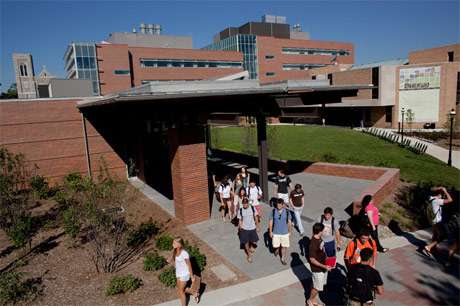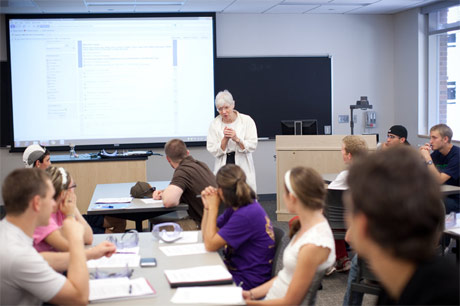Lehigh unveils an environmental showcase
Lehigh’s STEPS (Science, Technology, Environment, Policy and Society) building, the university’s largest investment in a decade in undergraduate science and engineering education, has opened for classes and research.
Faculty members and graduate students in earth and environmental sciences and in environmental engineering moved into the $62-million building over the summer. Classes began Aug. 30, the first day of the fall semester.
The 135,000-square-foot structure is part of the $85-million STEPS initiative, which is assembling engineers, natural scientists and social scientists to work on problems in energy and environmental sustainability.
A faculty committee worked five years with the office of facilities services and campus planning to plan the STEPS building. The building’s architect, Bohlin Cywinski Jackson of Philadelphia, also designed the Alumni Memorial Building’s arrival court and parking garage.
The planners’ goal, says Frank Pazzaglia, department chair of earth and environmental sciences (EES), was to promote the interaction of people and the exchange of ideas.
A flow of people and ideas
“The planning committee,” says Pazzaglia, codirector of the Environmental Initiative (EI), “put a ton of effort into designing labs, classrooms and open spaces so that one activity would flow into another.”
STEPS’ three wings form an L at the northeast corner of Packer Avenue and Vine Street. Packard Laboratory stands across Packer Avenue. An enclosed walkway joins STEPS to Maginnes Hall.
The A wing houses the administrative offices of the EES department, the environmental engineering faculty, the EI and the Energy Systems Engineering Institute. Faculty offices are situated along the east face of the B and C wings. Research labs are interspersed with teaching labs and classrooms. Informal seating areas are equipped with whiteboards.
STEPS’ 50 new research and teaching labs include 10 teaching labs dedicated to undergraduate courses in biological sciences and chemistry. These contain state-of-the-art instrumentation, and more seats, hood space and preparation rooms.
A critical role for glass
The junction of the B and C wings contains STEPS’ largest open space—a five-story atrium whose glass curtain wall is etched with an image by artist Larry Kirkland of the roots, trunk and branches of a tree.
Throughout STEPS, glass highlights the activities of researchers and softens the boundaries between building and environment. Hallway windows look into labs, while display cases show off discoveries from past and present. A floor-to-ceiling window wall along the A wing’s north face looks onto a courtyard of native plants and grass. Windows in offices and labs feature fritted glass, vertical fins and horizontal sunshades that mitigate glare while allowing optimal sunlight to penetrate.
“The transparency,” says Tony Corallo, associate vice president for facilities services and campus planning, “helps eliminate boundaries between the inside and outside of the building. It also encourages a sense of community among the building’s occupants.”
Certification by the LEED Rating System
With a variety of features that minimize energy and water use while maximizing the benefit of natural light and heat, STEPS has been designed for silver certification by the Leadership in Energy and Environmental Design (LEED) Green Building Rating System. Also, an 8,000-square-foot green roof atop the A wing absorbs the sun’s heat and carbon-dioxide, and releases oxygen.
In addition to the EES department and the department of civil and environmental engineering, the faculty members affiliated with STEPS represent education, international relations, history, journalism and communication, political science, and sociology and anthropology.
The researchers believe their new proximity will make it possible to join forces on such areas of common interest as water quality, climate change, alternative energies, carbon capture and sequestration, and resource development.
“STEPS will help us develop overarching research programs that tie together the science, technology and policy issues that underlie virtually all modern environmental issues,” Pazzaglia says.
“Being under one roof,” says Derick Brown, EI codirector and associate professor of civil and environmental engineering, “will enable all of us working on environmentally related research to interact daily.
“We’re looking forward to moving from hallway conversations to collaborative research projects that take aim at some of the grand challenges facing society.”
Posted on:



